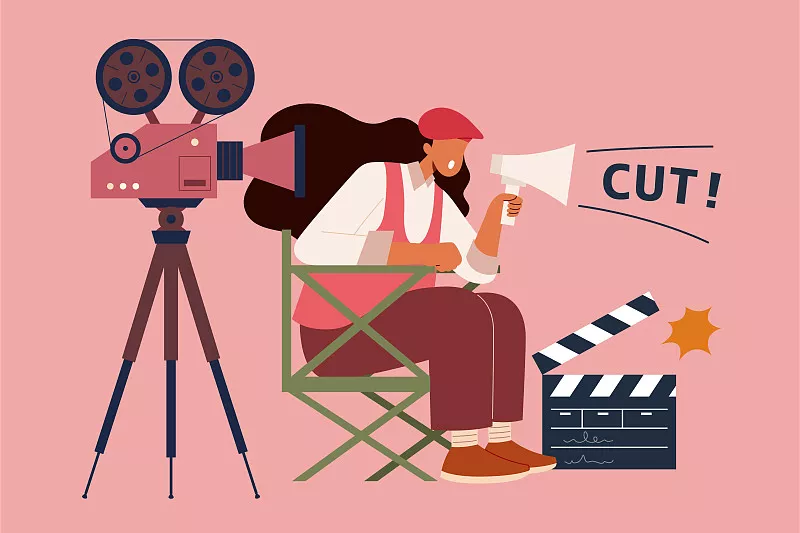About film and television creation.
This is an automatically translated post by LLM. The original post is in Chinese. If you find any translation errors, please leave a comment to help me improve the translation. Thanks!
Movies achieve a sense of naturalness through extreme deliberation.
Basic Process of Film and Television Production

- Scriptwriting
- Converting the script into storyboards
- Planning the shoot based on storyboards (grouping shots at the same location)
- Casting actors, securing shooting locations
- Preparing costumes, makeup, props
- Conducting the shoot
- Post-production
- Release
Film Shooting Process
Process:
- Upon arrival at the shooting location, the first step is to conduct a regular rehearsal of the scene to ensure the actors' emotional states are intact. Duct tape can be used on the ground to mark positions and aid actors in their movements.
- Pay attention to camera language and scene scheduling. Try to shoot all scenes from each camera angle to ensure the coherence of the actors' emotions.
- After the rehearsal, the camera and microphone conduct a preview to confirm the shooting effect.
- The director, cinematographer, sound recorder, and script supervisor confirm readiness.
- Turn on all microphones (compared to video files, audio files are much smaller and can be recorded multiple times for error tolerance).
- Start recording with the camera.
- The script supervisor places the slate in the focal point of the lens (near the shooting subject) and signals the scene, shot, and take. After slating, exit the scene.
- The director shouts "Three, two, one, action." Everyone remains quiet, and the actors begin their performance. Each department records according to the preview actions.
- The director shouts "Cut," the actors stop performing, and the recording for each department ends.
- Review the recording playback. If approved by the director, continue to the next shot; otherwise, repeat steps 4-9.
Notes:
- Camera recording files are large, especially with high-quality cameras, so try to minimize ineffective camera shooting time in the process.
- The slate is really important for organizing files in post-production! Really important! Really important!
- As the director shouts "Three, two, one," observe whether the script supervisor has exited the frame and adjust the pace according to the surrounding activities. Ensure silence and a clean frame after saying "action."
- Even if the actors have finished their lines, continue acting (improvising) until the director shouts "cut."
Shooting Equipment
Microphones: Large NTG3, Small H5
Voice-over: If post-production voice-over is needed, consider wrapping the recording equipment and voice-over actors with blankets to ensure clean sound without reverberation. This provides more room for audio post-processing.
Reflection: If encountering glass reflections, water surface reflections, or insufficiently clear skies during shooting, use polarizers in front of the lens to eliminate these reflections.
Slate: You can use a physical slate or use an app on an iPad or smartphone as a slate. The key is clarity in the shot.
Post-production
Sound
Main Volume: Between -12 and -6
Background Volume: Between -24 and -8
Use wired closed-back headphones for monitoring whenever possible.
Recommendations: Sennheiser, HD25SP, SONY7506
Image
Aspect Ratio:
- 1.85:1 for a cinematic feel
- 2.35:1 for widescreen (to compete with home TVs, the wider, the better for viewer perception).
- In the 1960s, 3D movies gradually disappeared. 2D can also tell a story well.
Video Format Conversion: Use Format Factory.
Insights
Film and television production is a meticulous process, with each step being crucial. Any issue in one step can affect the final result. Among them, storyboarding and shooting are particularly important. A good storyboard can streamline the shooting process and greatly improve efficiency. I believe a good storyboard should have the following characteristics:
- Accurate description, allowing visualization of the shot from the storyboard.
- Feasible shooting plans can be executed based on the storyboard.
- Allow for redundancy, adding some extra shots to increase editing flexibility.
During the shooting process, two points are crucial: adhering to the shooting schedule and strictly following the shooting process for each shot. Even for a short film, there can be dozens to hundreds of shots, and each shot may require multiple takes, resulting in a large number of files. Adhering to the shooting schedule and process ensures no shots are missed and greatly facilitates post-production. Additionally, pay attention to the following:
- After each shot, review the footage to check for any issues in recording quality.
- Use a slate for every shot, which greatly facilitates file organization in post-production.
- Naming convention for shooting files (recommended): Scene number_Shot number_Take number_Equipment ID_Equipment model.
- Ensure that the naming of recording files corresponds to shooting files for easy editing in post-production.
After shooting, organize the footage according to scene and shot numbers, including video and audio files.